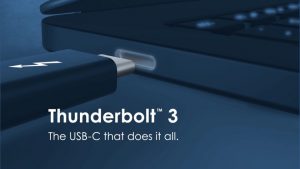Thunderbolt 3, which is a part of the Thunderbolt Technology, is designed to work in the same-shaped port as USB-C and is compatible with USB-C cables and devices. The original Thunderbolt and Thunderbolt 2 interfaces use mini Display Port-shaped connectors, which mean that they are entirely incompatible with any USB port. Intel envisions a world where one USB-C connector does it all. In this, one compact port could provide Thunderbolt 3 data transfer, support for two 4K 60 Hz displays, and quick notebook charging up to 100 W with a single cable. Any Thunderbolt or USB dock could also connect to a Thunderbolt 3 computer making it the most advanced and versatile USB-C docking port available. Thus, all the ports on future computers shall be the same with the ability to charge the system and connect to Thunderbolt devices, every display and billions of USB devices. The implementation of Intel’s vision shall offer a platform for computer manufacturers to build thinner and lighter systems with only Thunderbolt 3 ports. This is because designs based on this integration require less board space and reduce power by removing the discrete component needed for existing systems with Thunderbolt 3. In addition, Intel plans to make the Thunderbolt protocol specification available to the industry next year under a royalty-free license. This is expected to greatly increase Thunderbolt adoption by encouraging third-party chip makers to build Thunderbolt-compatible chips, and eventually accelerate a wide range of new devices and user experiences. Apple and Microsoft have already stamped their confidence in the innovation, and Intel says the standard shall be embedded in nearly 150 PC designs by the end of 2017. What is in Thunderbolt 3? Besides working as a USB-C cable, it has a lot of benefits that are coming along.
Faster Storage
With a transition from Serial ATA (SATA) drives to non-volatile memory (NVMe) SSDs for higher speed and lower latency storage, there is need to transfer large amounts of data to these devices at a quicker rate. Thunderbolt 3 does saves time with faster data transfers. A full 4K movie can be transferred in less than 30 seconds.
Best fit for Gamers
A gaming notebook can be paired with a Thunderbolt 3 external graphics box to get a GPU boost for higher resolution and settings experience. This gives a combination of mobility and performance, a hook up for interest on the go.
Virtual Reality Experience
It actually requires multiple cables to transfer the experience from the PC to the headset in real time for 2K resolution. Only Thunderbolt 3 can deliver up to 4K resolution in virtual reality with a single cable. With USB-C adoption on the rise for emerging devices, the anxiety can’t stop flowing in as we await on the Thunderbolt 3. Having a laptop that runs a single USB type will no more be a dream.

